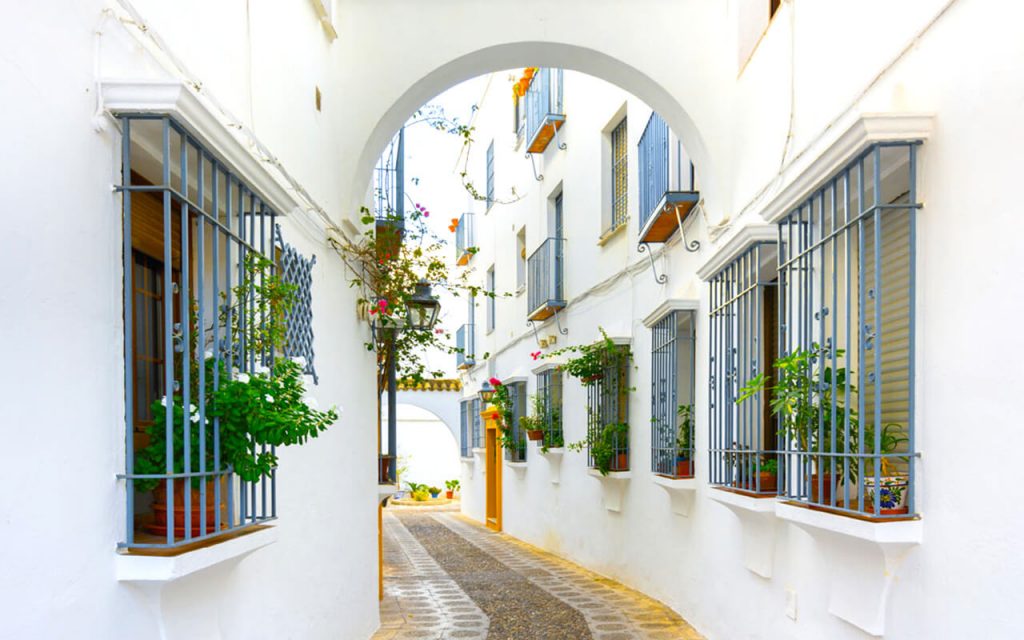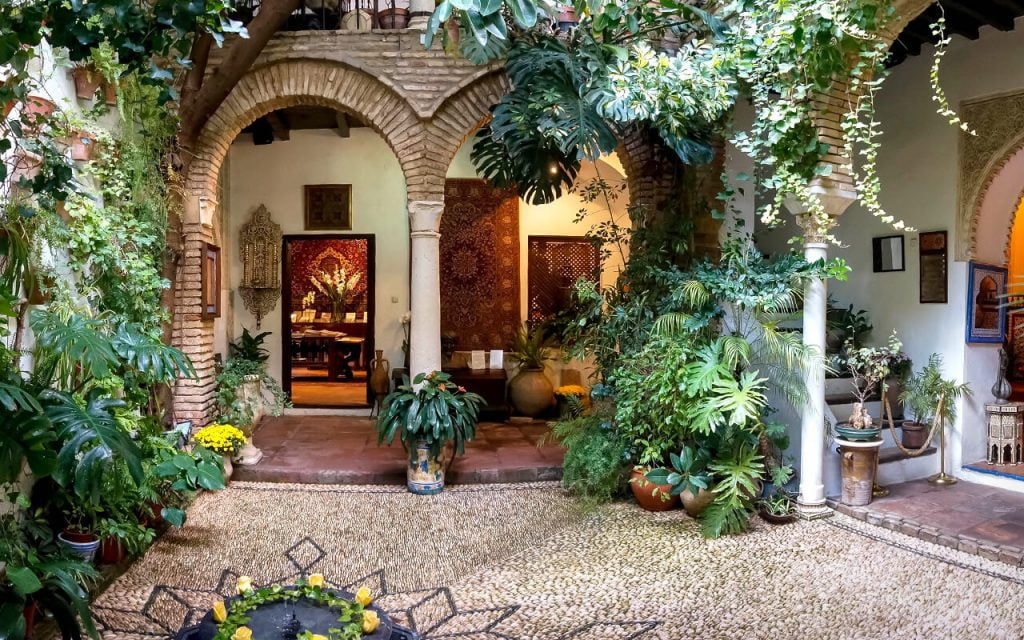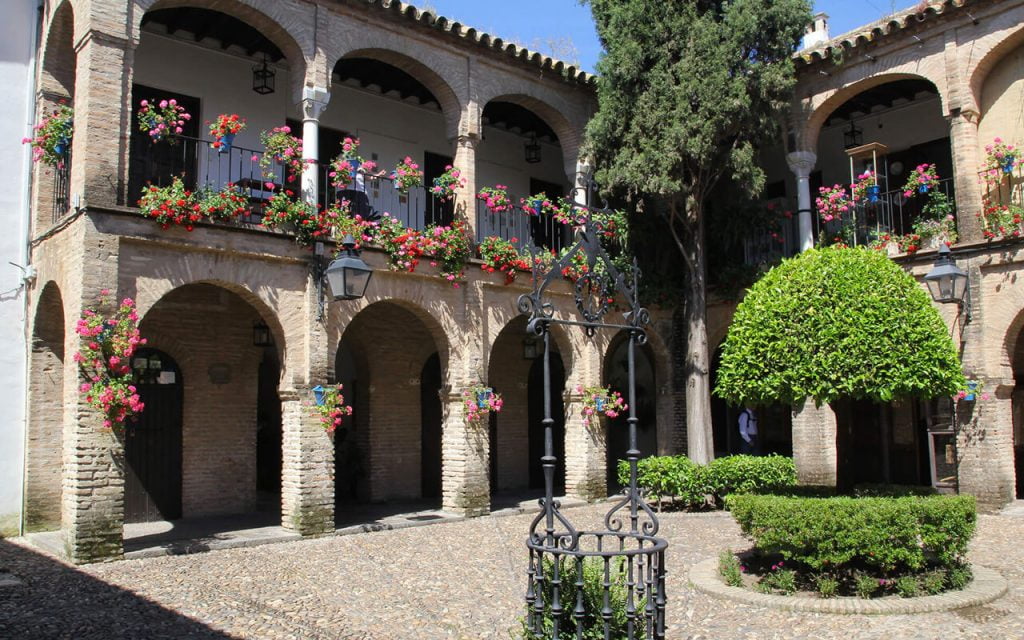Índice Contenido
The Jewish Quarter of Cordoba is a large neighborhood of the city that was inhabited by the Jews between the twelfth and fifteenth centuries. It is bounded by the streets Deanes, Tomás Conde, Judíos, Manríquez, Romero and Almanzor, as well as Rey Heredia Street to the west. In addition, it is located bordering the northern part of the Mosque-Cathedral of Cordoba. This historic environment has been declared a World Heritage Site by UNESCO and is undoubtedly one of the most visited tourist areas in Spain thanks to the unique architecture of houses and streets, as well as a magnificent state of preservation of monuments such as the Synagogue of Cordoba, the House of Sefarad, the Souk and the chapel of San Bartolomé.
How to get to the Jewish Quarter
La Judería is an area of the city of Córdoba located in the historic center. It is much more accessible on foot due to the impossibility of finding parking as well as the difficult driving through its cobblestone streets, mostly pedestrian. However, it is advisable to park the car in nearby neighborhoods such as Avenida del Flamenco (formerly Avenida Conde Vallellano), its subsequent Avenida de la Victoria or the southern part of the banks of the Guadalquivir River, next to Avenida de Cádiz. From there, enjoying the streets of the Jewish Quarter is a luxury that can only be experienced on foot.
Map of the Jewish Quarter of Cordoba
La Judería is a very large neighborhood full of endless and labyrinthine alleys, so it never hurts to have a map to program our tour.
History of the Jewish Quarter of Cordoba
The first information about the Jewish quarter of Cordoba dates back to the time of Emperor Augustus, during which a wall was built to prevent attacks from the enemies of Rome. This wall would be located along the edges of what would become in the future the Jewish quarter of Cordoba.
With the invasion of the Muslims in 711 A.D., the Jews were expelled from the walls of the city, settling their residence outside the walls. The Jewish Quarter has undergone changes throughout history and was originally located between the Jardines de la Merced and the Church of Santa Marina. The Jewish tombstone of Yehudá bar Akon, originally from 845 A.D., the funerary stone of the Church of San Miguel and the old Ossuary Gate, known as Bab-al-Yahud or the Gate of the Jews, date from this period.
With the fall of the Caliphate of Cordoba in 1013 AD and the subsequent invasion of the Almohads in 1148 AD, the Jews were expelled from the region. It was not until the conquest of Cordoba by the Christian King Ferdinand III that the Jews were able to reestablish themselves in the city. With the reign of Alfonso X the Wise, the Jewish Quarter was delimited to the space we know today. In 1315 the Synagogue of Cordoba was built thanks to the architect Isaac Moheb. It is the most iconic building of the Jewish presence in Cordoba.
.

Although Cordoba is known as the City of the three Cultures; a space of coexistence between Muslims, Christians and Jews, there were numerous revolts and conflicts between communities. One of the best known was the revolt of 1391 in which the Christians reprimanded Jews who lived throughout Castile, Aragon and Navarre. Numerous members of the community were looted, killed and forced to convert, and it even became necessary to repopulate the neighborhood. It was at this time that the Mudejar chapel of San Bartolomé, dated 1399, was built.
This was not the only attack, in fact, in 1406 King Henry III fined the citizens up to 40,000 doubloons to stop the vandalism. New revolts occurred in 1473 and 1478 and the inhabitants of the Jewish quarter had to be moved to the Alcázar Viejo neighborhood.
In 1492, however, Queen Isabella the Catholic carried out the so-called Edict of Granada, by which all Jews were expelled from the territory. They were given up to four months to leave the country, during which time the Synagogue of Cordoba became a hospital for hydrophobes and the chapel of Santa Quiteria.
What to see in the Jewish Quarter of Cordoba
Below, you will find the main monuments and symbolic places of the Jewish Quarter of Cordoba, a route of essential sites for tourists in the city.
Almodovar Gate
Known by the Arabs as the Puerta del Nogal (Walnut Gate), it is a walled entrance that connects directly to the Jewish quarter. It began to be known by this name because of its connection with the town of Almodóvar, especially after the conquest of the city in 1236.
Maimonides Square
This is a square located in the Jewish Quarter of Cordoba. It can be accessed from Judíos Street, Cardenal Salazar Square or Tomás Conde Street. Although it has also had other names such as Plaza de Las Armentas, Plaza del Arcediano and Plaza de Las Bulas, it currently bears the name of one of the most important thinkers of Cordoba’s culture. In this square we can find the Bullfighting Museum located in the so-called “Casa de las Bulas“, as well as a manor house belonging to the Counts of Hornachuelos.
The Synagogue of Cordoba
This religious building from the Middle Ages is unique in the whole of Andalusia. In fact, it is the third best preserved synagogue before the 15th century in Spain and its architecture has great Islamic artistic influences, as well as inscriptions in Hebrew. A symbol of Jewish heritage in Cordoba that will transport you to another era just by crossing its threshold.

Andalusi House
It is a museum located in a building of the XII century. Its objective is to show how it was to live in the ancient Al-Andalus, being able to visit all the rooms of the house. From the bedrooms, kitchen, main living room to a Cordovan courtyard with its traditional cobblestone fountain.
Mudejar Chapel of San Bartolomé
After the revolt of 1391, the Jews were evicted to other neighborhoods, leaving the Jewish quarter at the mercy of the Christians. At this time, construction began on this Mudejar-style chapel, which is composed of blue Nasrid tiles and traditional plasterwork. It was finally left unfinished due to lack of budget. It is located in the Faculty of Philosophy and Letters of the University of Cordoba, and can be accessed for 1.5 € on weekdays and 2 € on weekends and holidays.

Cordoba Souk
The Zoco is a market inaugurated in 1954 to showcase traditional products of Cordoba such as handicrafts and jodería, especially the tanning of cordobanes, ceramics and silverware. Around this building, you can find a multitude of stores and workshops of handicraft items from Cordoba.
Calleja de las Flores
It is a symbol of the Jewish Quarter of Cordoba and one of the most recognizable places in photographs. It is a very narrow alley with pots of different colors along its entire length. At the end of the street, there is a small dead end square from which you can take pictures of the Mosque with the perspective of the unique alley. To get to the Calleja de las Flores, you can only access through the Calle Velázquez Bosco, which connects to the north gate of the Mosque.
Bullfighting Museum of Cordoba
This museum is located in Plaza Maimonides and is a reference point on the world of bullfighting and its history. It has a newspaper library for researchers and its building alone is a tourist attraction for its architecture and history. It consists of two floors and has a Cordovan courtyard in the back, belonging to the Zoco of Cordoba.
Photos of the Jewish Quarter of Cordoba
In this section you can enjoy the best photos and images of the Jewish Quarter of Cordoba, where you can appreciate its beauty, the particularity of the architecture and convince you to visit one of the most important historical heritages in the world.
Frequently asked questions about the Jewish Quarter of Cordoba
What is the Jewish Quarter of Cordoba?
It is a neighborhood of the city of Cordoba that was inhabited mainly by Jews and has its origins in the Middle Ages. It stands out for the artistic wealth and the spectacular state of preservation of its buildings as well as housing a multitude of monuments and museums.
When was the Jewish Quarter of Cordoba built?
The Jewish Quarter of Cordoba has its origins in Roman times, when the city was walled. However, the neighborhood as we know it today dates from the twelfth century after the Christian conquest of the city and its subsequent delimitation during the reign of Alfonso X the Wise.
How to get to the Jewish Quarter of Cordoba?
The Jewish quarter is mainly pedestrian so it is much more accessible on foot entering through the Puerta de Almodovar or the streets Almanzor, Buen Pastor, Blanco Belmonte, Rey Heredia, Encarnacion, Torrijos and Tomas Conde. Of course, the Jewish Quarter connects directly with the northern part of the Mosque-Cathedral of Cordoba.
What to see in the Jewish Quarter of Cordoba?
La Judería is an ideal neighborhood for strolling and enjoying a walk, due to its unique architecture and the spectacular atmosphere it generates. However, it is also home to iconic locations such as the Synagogue of Córdoba, the Calleja de las Flores, the Zoco de Córdoba, the Bullfighting Museum, the Mudejar Chapel of San Bartolomé, the Plaza de Maimónides and the Puerta de Almodóvar.
When were the Jews expelled from Cordoba?
The Jews were first expelled from the city of Cordoba after the Muslim conquest of 711 A.D. Later, after the invasion of the Almohads in 1148 A.D. Finally, with the Edict of Granada promulgated by Isabella the Catholic in 1492, all Jews were expelled from the country, giving them up to 4 months to leave.

